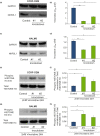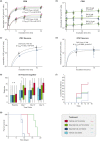Identification of small molecules that mitigate vincristine-induced neurotoxicity while sensitizing leukemia cells to vincristine
- PMID: 33742760
- PMCID: PMC8301581
- DOI: 10.1111/cts.13012
Identification of small molecules that mitigate vincristine-induced neurotoxicity while sensitizing leukemia cells to vincristine
Abstract
Vincristine (VCR) is one of the most widely prescribed medications for treating solid tumors and acute lymphoblastic leukemia (ALL) in children and adults. However, its major dose-limiting toxicity is peripheral neuropathy that can disrupt curative therapy. Peripheral neuropathy can also persist into adulthood, compromising quality of life of childhood cancer survivors. Reducing VCR-induced neurotoxicity without compromising its anticancer effects would be ideal. Here, we show that low expression of NHP2L1 is associated with increased sensitivity of primary leukemia cells to VCR, and that concomitant administration of VCR with inhibitors of NHP2L1 increases VCR cytotoxicity in leukemia cells, prolongs survival of ALL xenograft mice, but decreases VCR effects on human-induced pluripotent stem cell-derived neurons and mitigates neurotoxicity in mice. These findings offer a strategy for increasing VCR's antileukemic effects while reducing peripheral neuropathy in patients treated with this widely prescribed medication.
© 2021 The Authors. Clinical and Translational Science published by Wiley Periodicals LLC on behalf of the American Society for Clinical Pharmacology and Therapeutics.
Conflict of interest statement
The authors declared no competing interests for this work.
Figures





Similar articles
-
Association of an inherited genetic variant with vincristine-related peripheral neuropathy in children with acute lymphoblastic leukemia.JAMA. 2015 Feb 24;313(8):815-23. doi: 10.1001/jama.2015.0894. JAMA. 2015. PMID: 25710658 Free PMC article.
-
Vincristine-induced paralytic ileus during induction therapy of treatment protocols for acute lymphoblastic leukemia in adult patients.Int J Clin Pharmacol Ther. 2016 Jun;54(6):471-3. doi: 10.5414/CP202584. Int J Clin Pharmacol Ther. 2016. PMID: 27087157
-
Suppressing BRD4 exhibits protective effects against vincristine-induced peripheral neuropathy by alleviating inflammation and oxidative stress.Biochem Biophys Res Commun. 2020 Nov 5;532(2):271-279. doi: 10.1016/j.bbrc.2020.06.142. Epub 2020 Aug 29. Biochem Biophys Res Commun. 2020. PMID: 32868081
-
Vincristine sulfate liposomal injection for acute lymphoblastic leukemia.Int J Nanomedicine. 2013;8:4361-9. doi: 10.2147/IJN.S54657. Epub 2013 Nov 6. Int J Nanomedicine. 2013. PMID: 24232122 Free PMC article. Review.
-
Vincristine-induced neuropathy as the initial presentation of charcot-marie-tooth disease in acute lymphoblastic leukemia: a Pediatric Oncology Group study.J Pediatr Hematol Oncol. 2003 Apr;25(4):316-20. doi: 10.1097/00043426-200304000-00010. J Pediatr Hematol Oncol. 2003. PMID: 12679647 Review.
Cited by
-
Chemotherapy-induced peripheral neuropathy models constructed from human induced pluripotent stem cells and directly converted cells: a systematic review.Pain. 2024 Sep 1;165(9):1914-1925. doi: 10.1097/j.pain.0000000000003193. Epub 2024 Feb 21. Pain. 2024. PMID: 38381959 Free PMC article.
-
Local production of reactive oxygen species drives vincristine-induced axon degeneration.Cell Death Dis. 2023 Dec 8;14(12):807. doi: 10.1038/s41419-023-06227-8. Cell Death Dis. 2023. PMID: 38065950 Free PMC article.
-
Bridging the Translational Gap in Chemotherapy-Induced Peripheral Neuropathy with iPSC-Based Modeling.Cancers (Basel). 2022 Aug 15;14(16):3939. doi: 10.3390/cancers14163939. Cancers (Basel). 2022. PMID: 36010931 Free PMC article. Review.
-
Analgesic effects of medicinal plants and phytochemicals on chemotherapy-induced neuropathic pain through glial modulation.Pharmacol Res Perspect. 2021 Dec;9(6):e00819. doi: 10.1002/prp2.819. Pharmacol Res Perspect. 2021. PMID: 34676990 Free PMC article. Review.
-
Vincristine in Combination Therapy of Cancer: Emerging Trends in Clinics.Biology (Basel). 2021 Aug 31;10(9):849. doi: 10.3390/biology10090849. Biology (Basel). 2021. PMID: 34571726 Free PMC article. Review.
References
-
- Alam M, Yadav RK, Minj E, Tiwari A, Mehan S. Exploring molecular approaches in Amyotrophic lateral sclerosis: drug targets from clinical and pre‐clinical findings [published online ahead of print April 27, 2020). Curr Molec Pharmacol. https://doi.org/10.2174/1566524020666200427214356. - DOI - PubMed
-
- Bradley WG, Lassman LP, Pearce GW, Walton JN. The neuromyopathy of vincristine in man. Clinical, electrophysiological and pathological studies. J Neurol Sci. 1970;10:107‐131. - PubMed
-
- Gidding CEM, Meeuwsen‐de Boer GJ, Koopmans P, Uges DRA, Kamps WA, de Graaf SSN. Vincristine pharmacokinetics after repetitive dosing in children. Cancer Chemother. Pharmacol. 1999;44:203‐209. - PubMed
Publication types
MeSH terms
Substances
Grants and funding
LinkOut - more resources
Full Text Sources
Other Literature Sources
Medical

